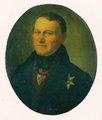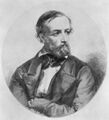Template:Selected anniversaries/July 27: Difference between revisions
No edit summary |
No edit summary |
||
| (One intermediate revision by the same user not shown) | |||
| Line 12: | Line 12: | ||
File:George Biddell Airy 1891.jpg|link=George Biddell Airy (nonfiction)|1801: Mathematician and astronomer [[George Biddell Airy (nonfiction)|George Biddell Airy]] born. His achievements will include work on planetary orbits, measuring the mean density of the Earth, and, in his role as Astronomer Royal, establishing Greenwich as the location of the prime meridian. | File:George Biddell Airy 1891.jpg|link=George Biddell Airy (nonfiction)|1801: Mathematician and astronomer [[George Biddell Airy (nonfiction)|George Biddell Airy]] born. His achievements will include work on planetary orbits, measuring the mean density of the Earth, and, in his role as Astronomer Royal, establishing Greenwich as the location of the prime meridian. | ||
File:Peter Gustav Lejeune Dirichlet.jpg|link=Peter Gustav Lejeune Dirichlet (nonfiction)|1837: [[Peter Gustav Lejeune Dirichlet (nonfiction)|Peter Dirichlet]] presented his first analytic number theory paper at a meeting of the Berlin Academy of Sciences. He proved the fundamental theorem that bears his name: Every arithmetical sequence an + b, n = 0, 1, 2, ... of integers, where a and b are relatively prime, contains infinitely many primes. | File:Peter Gustav Lejeune Dirichlet.jpg|link=Peter Gustav Lejeune Dirichlet (nonfiction)|1837: [[Peter Gustav Lejeune Dirichlet (nonfiction)|Peter Dirichlet]] presented his first analytic number theory paper at a meeting of the Berlin Academy of Sciences. He proved the fundamental theorem that bears his name: Every arithmetical sequence an + b, n = 0, 1, 2, ... of integers, where a and b are relatively prime, contains infinitely many primes. | ||
| Line 54: | Line 52: | ||
||1931: Auguste Forel dies ... myrmecologist, neuroanatomist, psychiatrist and eugenicist, notable for his investigations into the structure of the human brain and that of ants. For example, he is considered a co-founder of the neuron theory. Forel is also known for his early contributions to sexology and psychology. Pic. | ||1931: Auguste Forel dies ... myrmecologist, neuroanatomist, psychiatrist and eugenicist, notable for his investigations into the structure of the human brain and that of ants. For example, he is considered a co-founder of the neuron theory. Forel is also known for his early contributions to sexology and psychology. Pic. | ||
File:Gary Gygax Gen Con 2007.jpg|link=Gary Gygax (nonfiction)|1938: Game designer [[Gary Gygax (nonfiction)|Gary Gygax]] born. | File:Gary Gygax Gen Con 2007.jpg|link=Gary Gygax (nonfiction)|1938: Game designer [[Gary Gygax (nonfiction)|Gary Gygax]] born. | ||
| Line 65: | Line 61: | ||
||1960: Julie Vinter Hansen dies ... astronomer and academic. Pic. | ||1960: Julie Vinter Hansen dies ... astronomer and academic. Pic. | ||
||1963: Garrett Morgan dies ... inventor. Pic. | |||
File:Cantor Parabola.jpg|link=Cantor Parabola|1973: Math photographer [[Cantor Parabola]] takes advance photographs of the House of Representatives Judiciary Committee voting to recommend the first article of impeachment against President Nixon. | File:Cantor Parabola.jpg|link=Cantor Parabola|1973: Math photographer [[Cantor Parabola]] takes advance photographs of the House of Representatives Judiciary Committee voting to recommend the first article of impeachment against President Nixon. | ||
File:Nixon April-29-1974.jpg|link=Watergate scandal (nonfiction)|1974: [[Watergate scandal (nonfiction)]]: The House of Representatives Judiciary Committee votes 27 to 11 to recommend the first article of impeachment (for obstruction of justice) against President Richard Nixon. | File:Nixon April-29-1974.jpg|link=Watergate scandal (nonfiction)|1974: [[Watergate scandal (nonfiction)]]: The House of Representatives Judiciary Committee votes 27 to 11 to recommend the first article of impeachment (for obstruction of justice) against President Richard Nixon. | ||
||1982: Joseph Oscar Irwin dies ... statistician who advanced the use of statistical methods in biological assay and other fields of laboratory medicine. Irwin’s grasp of modern mathematical statistics distinguished him not only from older medical statisticians like Major Greenwood but contemporaries like Austin Bradford Hill. Pic. | ||1982: Joseph Oscar Irwin dies ... statistician who advanced the use of statistical methods in biological assay and other fields of laboratory medicine. Irwin’s grasp of modern mathematical statistics distinguished him not only from older medical statisticians like Major Greenwood but contemporaries like Austin Bradford Hill. Pic. | ||
| Line 83: | Line 79: | ||
||2015: John William Scott "Ian" Cassels dies ... mathematician ... writing a series of papers connecting the Selmer group with Galois cohomology and laying some of the foundations of the modern theory of infinite descent[citation needed]. His best-known single result may be the proof that the Tate-Shafarevich group, if it is finite, must have order that is a square; the proof being by construction of an alternating form. Pic: http://www.learn-math.info/mathematicians/historyDetail.htm?id=Cassels&menuH=wiki | ||2015: John William Scott "Ian" Cassels dies ... mathematician ... writing a series of papers connecting the Selmer group with Galois cohomology and laying some of the foundations of the modern theory of infinite descent[citation needed]. His best-known single result may be the proof that the Tate-Shafarevich group, if it is finite, must have order that is a square; the proof being by construction of an alternating form. Pic: http://www.learn-math.info/mathematicians/historyDetail.htm?id=Cassels&menuH=wiki | ||
</gallery> | </gallery> | ||
Latest revision as of 10:23, 7 February 2022
1737: Natural scientist, explorer, and clergyman Erik Laxmann born. Laxmann will contribute to the taxonomy of Siberian fauna, and attempt to establish relations between Imperial Russia and Tokugawa Japan.
1801: Mathematician and astronomer George Biddell Airy born. His achievements will include work on planetary orbits, measuring the mean density of the Earth, and, in his role as Astronomer Royal, establishing Greenwich as the location of the prime meridian.
1837: Peter Dirichlet presented his first analytic number theory paper at a meeting of the Berlin Academy of Sciences. He proved the fundamental theorem that bears his name: Every arithmetical sequence an + b, n = 0, 1, 2, ... of integers, where a and b are relatively prime, contains infinitely many primes.
1844: Chemist, meteorologist, and physicist John Dalton dies. He proposed the modern atomic theory, and did research in color blindness.
1871: Logician and mathematician Ernst Friedrich Ferdinand Zermelo born. His work will have major implications for the foundations of mathematics; he will be known for his role in developing Zermelo–Fraenkel axiomatic set theory, and for his proof of the well-ordering theorem.
1928: Electrical engineer and physicist John Ambrose Fleming marries the popular young singer Olive May Franks of Bristol.
1938: Game designer Gary Gygax born.
1973: Math photographer Cantor Parabola takes advance photographs of the House of Representatives Judiciary Committee voting to recommend the first article of impeachment against President Nixon.
1974: Watergate scandal (nonfiction): The House of Representatives Judiciary Committee votes 27 to 11 to recommend the first article of impeachment (for obstruction of justice) against President Richard Nixon.








